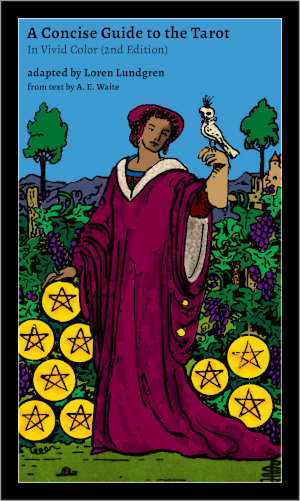Tarot Reading dasdasd
Reading Performed 02/07/2024 at 1:51 PM
Click or scroll down for the meaning of each position and the interpretation of its card.
Querent
The querent is the card that this user felt represented them or their situation best.
Visual Layout
The Meanings of these Tarot Cards
This Covers You
This card gives the influence which is affecting the person or matter of inquiry generally, the atmosphere of it in which the other currents work.
The Devil from the Marseilles Pattern Tarot Deck
A. E. Waite's Secondary Meanings
The Devil. In the eighteenth century this card seems to have been rather a symbol of merely animal impudicity. Except for a fantastic head-dress, the chief figure is entirely naked; it has bat-like wings, and the hands and feet are represented by the claws of a bird. In the right hand there is a sceptre terminating in a sign which has been thought to represent fire. The figure as a whole is not particularly evil; it has no tail, and the commentators who have said that the claws are those of a harpy have spoken at random. There is no better ground for the alternative suggestion that they are eagle's claws. Attached, by a cord depending from their collars, to the pedestal on which the figure is mounted, are two small demons, presumably male and female. These are tailed, but not winged. Since 1856 the influence of Eliphas Levi and his doctrine of occultism has changed the face of this card, and it now appears as a pseudo-Baphometic figure with the head of a goat and a great torch between the horns; it is seated instead of erect, and in place of the generative organs there is the Hermetic caduceus. In Le Tarot Divinatoire of Papus the small demons are replaced by naked human beings, male and female who are yoked only to each other. The author may be felicitated on this improved symbolism.
This Crosses You
It shows the nature of the obstacles in the matter. If it is a favourable card, the opposing forces will not be serious, or it may indicate that something good in itself will not be productive of good in the particular connexion.
This Crowns You
It represents (a) the Querent €™s aim or ideal in the matter; (b) the best that can be achieved under the circumstances, but that which has not yet been made actual.
The Emperor from the Marseilles Pattern Tarot Deck
A. E. Waite's Secondary Meanings
The Emperor, by imputation the spouse of the former. He is occasionally represented as wearing, in addition to his personal insignia, the stars or ribbons of some order of chivalry. I mention this to shew that the cards are a medley of old and new emblems. Those who insist upon the evidence of the one may deal, if they can, with the other. No effectual argument for the antiquity of a particular design can be drawn from the fact that it incorporates old material; but there is also none which can be based on sporadic novelties, the intervention of which may signify only the unintelligent hand of an editor or of a late draughtsman.
This is Beneath You
It shows the foundation or basis of the matter, that which has already passed into actuality and which the Significator has made his own.
This is Behind You
It gives the influence that is just passed, or is now passing away.
This is Before You
It shows the influence that is coming into action and will operate in the near future.
Your Self
Signifies the person or thing about which the question has been asked, and shows its position or attitude in the circumstances.
Your House
Your environment and the tendencies at work therein which have an effect on the matter €”for instance, your position in life, the influence of immediate friends, and so forth.
Your Hopes and Fears
The Final Result
The culmination which is brought about by the influences shewn by the other cards that have been turned up in the divination.
The Star from the Marseilles Pattern Tarot Deck
A. E. Waite's Secondary Meanings
The Star, Dog-Star, or Sirius, also called fantastically the Star of the Magi. Grouped about it are seven minor luminaries, and beneath it is a naked female figure, with her left knee upon the earth and her right foot upon the water. She is in the act of pouring fluids from two vessels. A bird is perched on a tree near her; for this a butterfly on a rose has been substituted in some later cards. So also the Star has been called that of Hope. This is one of the cards which Court de Gebelin describes as wholly Egyptian-that is to say, in his own reverie.























